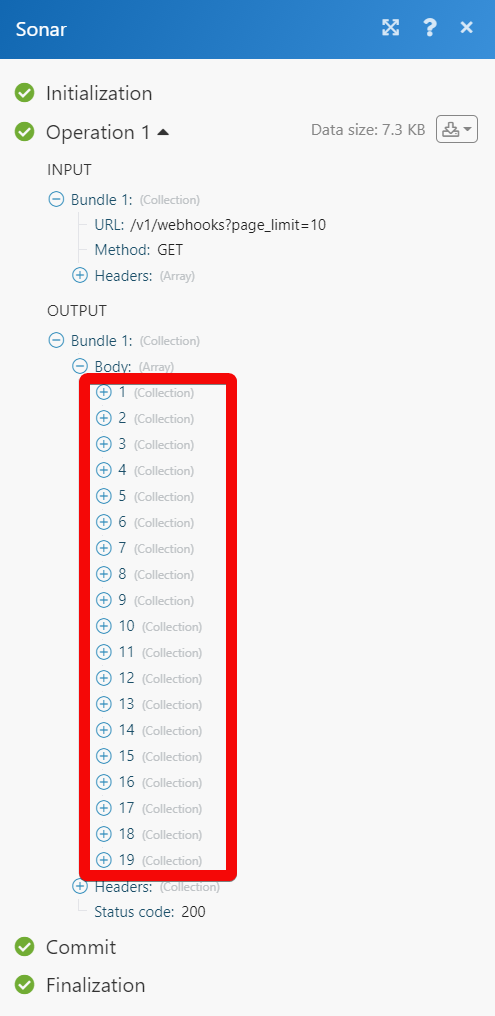| Active with remarks |
|---|
| This application needs additional settings. Please follow the documentation below to create your own connectionUnique, active service acces point to a network. There are different types of connections (API key, Oauth…). More. |
The Sonar modulesThe module is an application or tool within the Boost.space system. The entire system is built on this concept of modularity. (module - Contacts) More allow you to monitor, create, update, retrieve, close, and delete the customers, monitor, and send the messages and campaigns.
Prerequisites
-
A Sonar account –create an account at sendsonar.com/
![[Note]](https://docs.boost.space/wp-content/themes/bsdocs/docs-parser/HTML/css/image/note.png) |
Note |
|---|---|
|
The moduleThe module is an application or tool within the Boost.space system. The entire system is built on this concept of modularity. (module - Contacts) More dialog fields that are displayed in bold (in the Boost.spaceCentralization and synchronization platform, where you can organize and manage your data. More IntegratorPart of the Boost.space system, where you can create your connections and automate your processes. More scenarioA specific connection between applications in which data can be transferred. Two types of scenarios: active/inactive. More, not in this documentation article) are mandatory! |
To connect your Sonar account to Boost.space Integrator you need to obtain the private tokenThe API token is a multi-digit code that allows a user to authenticate with cloud applications. More from your Sonar account and insert it in the Create a connection dialog in the Boost.space Integrator module.
1. Log in to your Sonar account.
2. Click the left menu icon ( ) > Company Settings.
) > Company Settings.
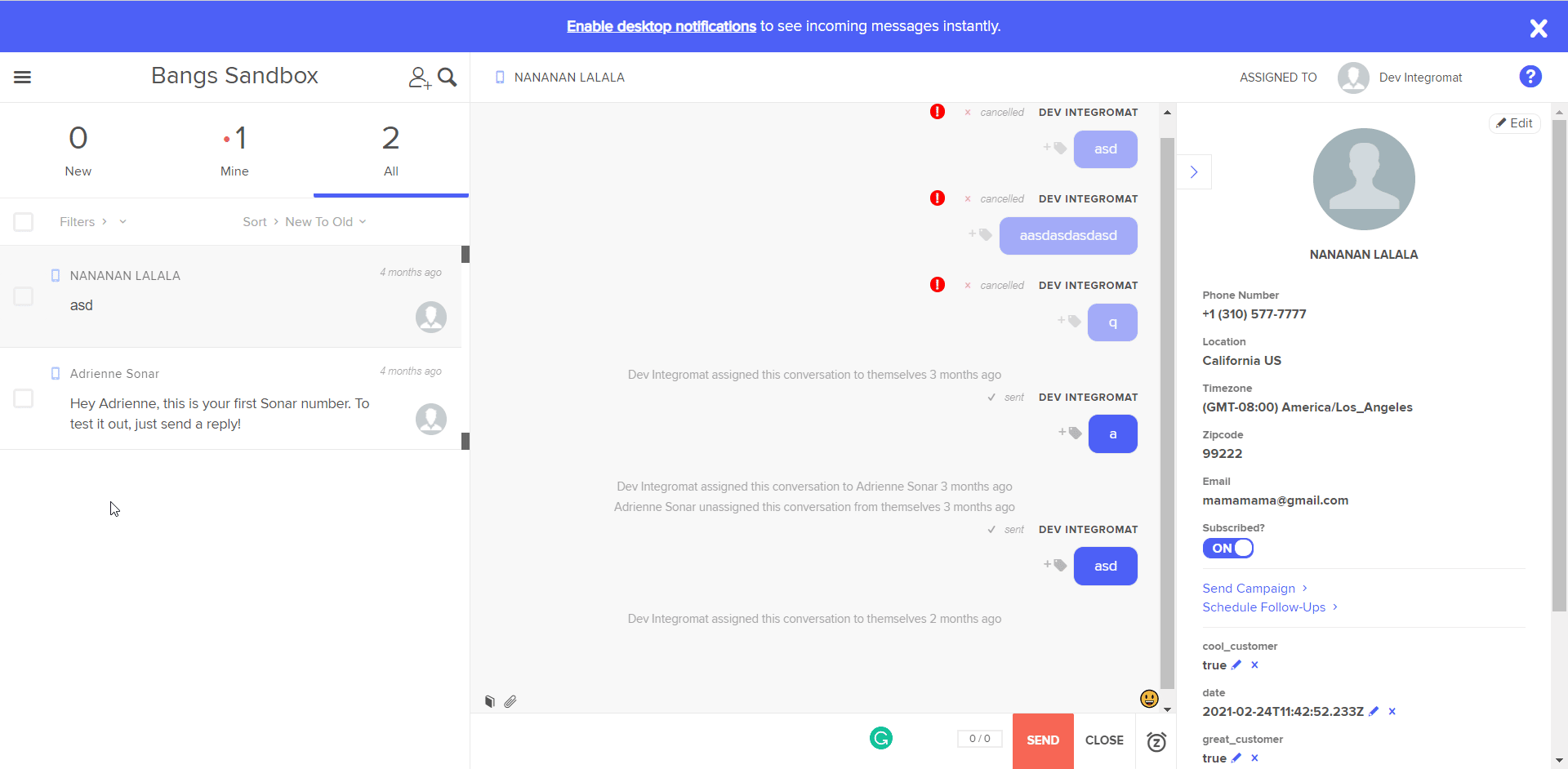
3. Copy the Private Token to your clipboard.
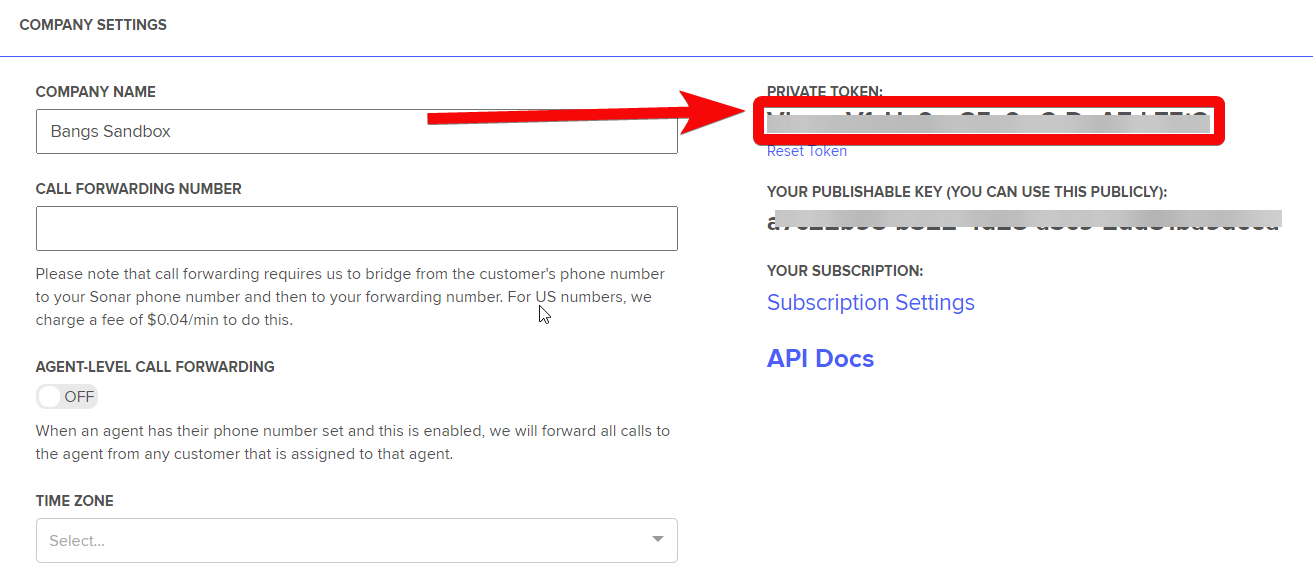
4. Go to Boost.space Integrator and open the Sonar module’s Create a connection dialog.
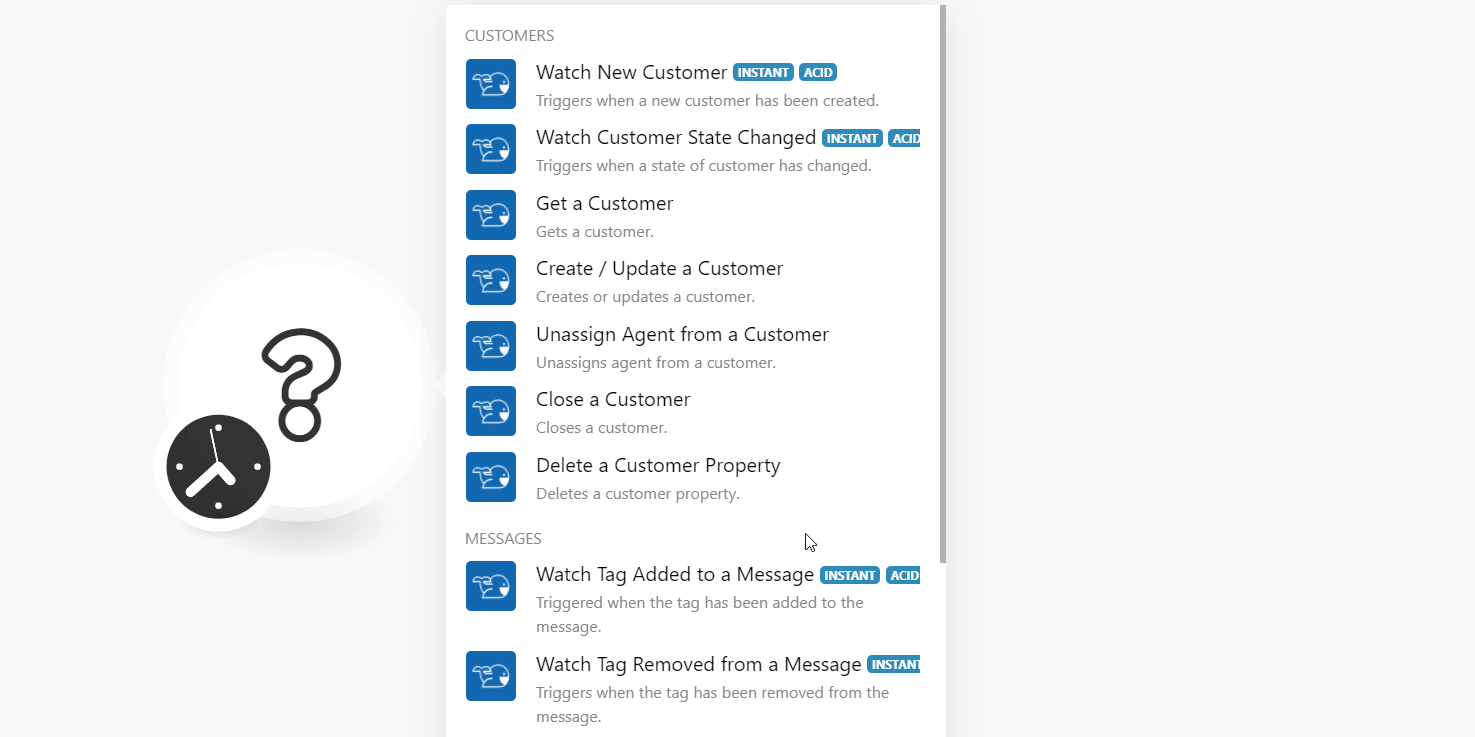
5. In the Connection name field, enter a name for the connection.
6. In the Private Token field, enter the token copied in step 3.
7. (Optional) Select the Sandbox checkbox if you are using a sandbox account, and click Continue.
The connection has been established.
TriggersEvery scenario has a trigger, an event that starts your scenario. A scenario must have a trigger. There can only be one trigger for each scenario. When you create a new scenario, the first module you choose is your trigger for that scenario. Create a trigger by clicking on the empty module of a newly created scenario or moving the... when a new customer has been created.
![[Note]](https://docs.boost.space/wp-content/themes/bsdocs/docs-parser/HTML/css/image/note.png) |
Note |
|---|---|
|
You do not have to add the webhooksA webhook is a way for an app to send real-time information to a specific URL in response to certain events or triggers. in the Sonar as it is automatically done for you once you add and save an instant triggerEvery scenario has a trigger, an event that starts your scenario. A scenario must have a trigger. There can only be one trigger for each scenario. When you create a new scenario, the first module you choose is your trigger for that scenario. Create a trigger by clicking on the empty module of a newly created scenario or moving the... module to your scenario. |
|
WebhookA webhook is a way for an app to send real-time information to a specific URL in response to certain events or triggers. Name |
Enter a name for the webhook. |
|
Connection |
Triggers when the state of the customer has changed.
|
Webhook Name |
Enter a name for the webhook. |
|
Connection |
Gets a customer.
|
Connection |
|
|
Phone Number |
Enter (map) the phone number of the customer whose details you want to retrieve. For example, |
Creates/updates a customer.
|
Connection |
|
|
Phone Number |
Enter (map) the phone number of the customer whose property you want to delete. |
|
First Name |
Enter (map) the customer’s first name. |
|
Last Name |
Enter (map) the customer’s last name. |
|
Email Address |
Enter (map) the customer’s email address. |
|
Properties |
Add the properties for the customer: Property Name – Enter (map) the property name. For example, Type – Select or map the data type. For example, Value – Enter (map) the property value. For example, |
|
Picture URL |
Enter (map) the URL address to the customer profile picture. |
|
Subscribed |
Select whether the customer is subscribed to receive the API messages and mass messages. |
|
UserCan use the system on a limited basis based on the rights assigned by the admin. More Email |
Enter (map) the email address of the user who is assigned to the customer. |
|
ZIP Code |
Enter (map) the customer area ZIP code. For example, |
|
Timezone |
Select or map the customer’s timezone. |
Unassigns an agent from a customer.
|
Connection |
|
|
Phone Number |
Enter (map) the phone number of the customer whose agent you want to unassign from the customer. For example, |
Closes a customer.
|
Connection |
|
|
Phone Number |
Enter (map) the phone number of the customer you want to close. For example, |
Deletes a customer property.
|
Connection |
|
|
Phone Number |
Enter (map) the phone number of the customer whose property you want to delete. For example, |
|
Property Name |
Enter (map) the property name you want to delete. |
![[Note]](https://docs.boost.space/wp-content/themes/bsdocs/docs-parser/HTML/css/image/note.png) |
Note |
|---|---|
|
You do not have to add the webhooks in the Sonar as it is automatically done for you once you add and save an instant trigger module to your scenario. |
Triggers when the tag has been added to the message.
|
Webhook Name |
Enter a name for the webhook. |
|
Connection |
Triggers when the tag has been removed from the message.
|
Webhook Name |
Enter a name for the webhook. |
|
Connection |
Triggers when getting the outbound message.
|
Webhook Name |
Enter a name for the webhook. |
|
Connection |
Triggers when getting the new assigned message.
|
Webhook Name |
Enter a name for the webhook. |
|
Connection |
Triggers when getting the new unassigned message.
|
Webhook Name |
Enter a name for the webhook. |
|
Connection |
Sends a message.
|
Connection |
|
|
Phone Number |
Enter (map) the phone number to which you want to send the message. |
|
Text |
Enter (map) the message text. |
|
Media URL |
Enter (map) the URL address of the image or video you want to attach to the message. |
|
Tag Names |
Add the tags applicable to the message. |
Appends tag to an existing message.
|
Connection |
|
|
External Message ID |
Enter (map) the External Message ID to which you append the tag. You can get this value only from the Webhook payload. |
|
Tag Name |
Select or map the tag you want to append to the message. For example, |
Sends a campaign.
|
Connection |
|
|
Campaign ID |
Enter (map) the Campaign ID you want to send. For example, |
|
To |
Enter (map) the phone number of the customer to whom you want |
|
Send at |
Enter (map) the date and time when you want to send the campaign. See the list of supported date and time formats. |
Performs an arbitrary authorized API call.
|
Connection |
||||
|
URL |
Enter a path relative to
|
|||
|
Method |
Select the HTTP method you want to use: GET to retrieve information for an entry. POST to create a new entry. PUT to update/replace an existing entry. PATCH to make a partial entry update. DELETE to delete an entry. |
|||
|
Headers |
Enter the desired request headers. You don’t have to add authorization headers; we already did that for you. |
|||
|
Query String |
Enter the request query string. |
|||
|
Body |
Enter the body content for your API call. |
The following API call returns all the webhooks from your Sonar account:
URL: /v1/webhooks
Method: GET
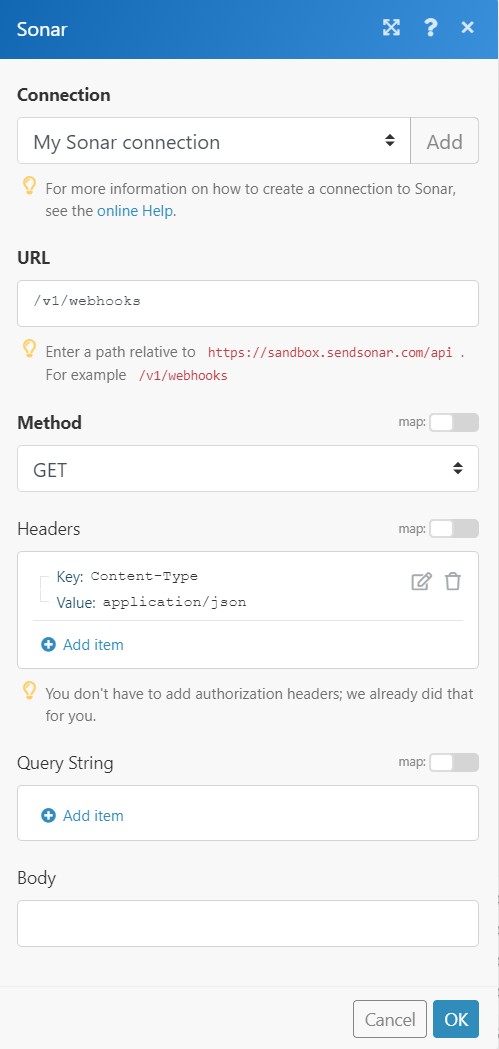
Matches of the search can be found in the module’s Output under BundleA bundle is a chunk of data and the basic unit for use with modules. A bundle consists of items, similar to how a bag may contain separate, individual items. More > Body. In our example, 19 webhooks were returned:
